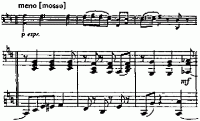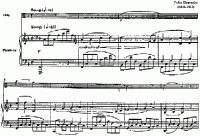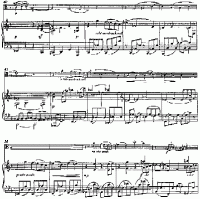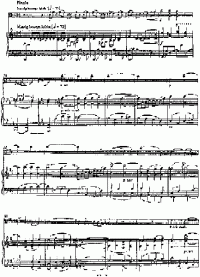The Viola Alta and Felix Draeseke's Sonatas
by Franco Sciannameo
|
|
Violists have two new additions to their Romantic repertoire with the recent publication of two Sonatas for Viola Alta and Piano, by Felix Draeseke. As study material these pieces offer teacher and pupil some enticing opportunities for probing the composer's stylistic versatility. Both sonatas are eminently playable on the normal viola, and players should not be put off by their unfamiliarity with the viola alta, described below. The Mystique of the Viola Alta Richard Strauss was the last to mention the viola alta in his revised edition of Berlioz's Grand Traité d'instrumentation et d'orchestration modernes (1843). He wrote, ''The Viola alta constructed by a Professor Hermann Ritter had a fifth string tuned to e". Its large size gave it greater volume, and of course it had a higher range, very advantageous for modern orchestral works. Its requirements of 'greater physical power' from the player is credited with its limited use.' [1] Eduard Hanslick, the celebrated Viennese critic, also remembered the viola alta in his Vienna's Golden Years of Music, 1850-1900. ''Of stronger construction than the common viola [the viola alta] surpasses it in fullness of tone and reduces the all-too-great distance normally separating violas and violoncello. It was adopted by Wagner for Bayreuth,'' he wrote[2]. In essence, both Strauss and Hanslick placed the viola alta on the shelf among the many discarded experimentations to which violas have been subjected over the centuries. On rare occasions, however, this unusual artifact gets dusted off, if not always for practical reasons, certainly for historical curiosity. Hermann Ritter (1849-1926), German violist and music historian, dedicated his professional life to promoting and perfecting a type of viola destined to elevate the instrument in the eyes of his idol Richard Wagner, whose low opinions of the violists of his time were well-known. ''The viola is commonly (with rare exceptions indeed) played by infirm violinists, or by decrepit players of wind instruments who happen to have been acquainted with a stringed instrument once upon a time,'' began one Wagner excerpt. ''It was pointed out to me that in a large orchestra which contained eight violas, there was only one player who could deal with the rather difficult passages on one of my later scores!''[3] Ritter was also interested in rescuing the viola from the hands of those ''foreigners'' who continued to play small violas out of their physical ineptitude or laziness. Egon Voss has explained that Wagner often used the viola in connection with Kundry in Act I of Parsifal and with Loge throughout the Ring, two figures who share much with other anti-Semitic (foreign) representations. Also, the viola is very closely associated with that of other nefarious stumblers, like Mime in Der Ring des Nibelungen. The ''infirm, decrepit'' musician, moonlighting on the viola so much deprecated by Wagner, did represent for Ritter the un-Germanic, unwholly, ''foreign'' type of violist he and Wagner wished to dispense with[4]. In sum, the viola alta had become for Hermann Ritter the ''Teutonic'' viola, an instrument of Wagnerian magnitude in every respect. Publicly introduced by its inventor in 1876, the viola alta was built in Wütrzburg by Karl Adam Hörlein (1829-1902) as an exact enlargement of the violin. Its drawings incorporated some of the acoustical principles espoused by Antonio Bagatella in his Regole per la costruzione di violini, viole, violoncelli e violoni..., written in 1782 and published in 1786. The instrument Ritter and Hörlein built in 1875 had a body length of 48 cm. (18.9 in.), and ribs of 4.3 cm. (1.7 in.). In Munich Ritter played the new viola alta for Wagner who was quick to show appreciation and support for the musician's efforts. In a tee he sent to letter on March 28, 1875, Wagner wrote: ''... I feel certain that the universal introduction of the Viola Alta unto our orchestras would serve not only to throw a proper light on the intention of those composers who had to content themselves with the ordinary Bratsche while they required for their melody the true Alto-violin tone, but that it might also bring about an advantageous change in the treatment of the string quartet.... A courageous beginning will, however, draw followers and finally conductors, and directors will have to encourage the good example.''[5] Ritter played his viola alta in Bayreuth at the premiere of Der Ring des Nibelungen in 1876. By 1889, five of Ritter's pupils were in the Bayreuth orchestra playing the viola alta. ''Herman Ritter was a large man and could play the Viola alta with apparent ease,'' wrote Maurice W. Riley. ''Most violists, however, found the instrument to be too large. Those that [sic] could barely reach first position complained that the upper bout was so wide that they could not play in the higher positio'' [6]. In 1898, in attempting to correct the situation, Ritter and Hörlein produced a new five-stringed viola alta by adding the violin E, the instrument had a body length of 45.4 cm. (17-7/8 in.). This idea was not new, however. Prior to 1834, Niccoló Paganini commissioned a luthier from Forlií, Francesco ''Tino'' Borghi, to build for him a five-stringed viola thereafter referred to as the Paganini controviola [7]. Finally in 1905 Ritter presented an entire new string quartet. The first violin was of standard size. The second violin part was played on his five-stringed viola alta. The third part was played on a new instrument, the viola tenore, which had a body length of 72 cm. (28 1/3 in.), held cello style; and ultimately the viola bassa, tuned like but larger than the cello, 96 cm. (37.8 in.). Felix Draeseke's Two Sonatas for Viola Alta and Piano A small body of solo music was composed for the viola alta, including two sonatas by Felix Draeseke. Felix Draeseke (Coburg, 1835-Dresden, 1913), a pupil of the Leipzig Conservatory and of Franz Liszt in Weimar, held a teaching position in Lausanne before settling in Dresden in 1876 where, in 1884, he became professor of composition at the conservatory. He composed the operas Gudrun (1884), Herrat (1892), Bertran de Born (text and music, 1892-94), Fischer und Kalif (1905), and Merlin (1913); The ''Mysterium'' Christus, comprising a prologue and three separate oratorios; much church music, four symphonies, concertos, a sizable amount of chamber music, and theoretical works. The Sonata No. 1 in C Minor was composed in 1893 at the request of Rudolf Remmele who wished to have a major work for the viola alta at a time when Draeseke had recommended the use of the instrument in the score of his opera Bertran de Born. The sonata is in three movements: Moderato elegiaco - Larghetto - Allegretto.
The second movement, Larghetto, is like an extensive foray into German Romanticism. It begins with the tranquility of a Beethoven slow movement and develops into daring thoughts of Brucknerian spaciousness. (See Example 4.) The concluding Allegretto begins like a sarcastic tambourin followed by a wishful tune as to reassure the listener that everything is all right with the world, despite the melancholy of the preceding movement and the inevitable fin-de-siècle malaise. This lengthy finale, which combines rondo and sonata form techniques including an intricate fugato, comes to an end through a mounting conclusion written in the best Lisztian tradition. No question the Sonata No. 1 in G Minor is a major work by a major Romantic composer. Although published for the first time in 1935 and again in 1985, it has escaped the violist's attention, at least as far as public performances are concerned. Ten years after composing the Sonata in C Minor, Draeseke received a request from friend Theodor Röhmeyer to compose another sonata for the viola alta. The new piece was going to be a present for Hermann Ritter. Apparently Ritter, Krueck writes, ''was not aware of Draeseke's earlier Sonata for he wrote to Röhmeyer in late 1901: 'Now that's really something! A Sonata for the Altgeige and piano by the master Draeseke! I couldn't permit myself any type of judgment concerning such a tone poet. Whatever he writes, it is always fitting!'''[8]. Although the work, composed between October 1901 and January 1902, was privately performed in 1904, it remained unpublished until now. The Wollenweber publication is based on Draeseke's autograph, which is preserved at the Saxon Suite Library in Dresden.
The second movement is a full-scale Passacaglia rich in harmonic surprises and unpredictable turns of phrase. One might hear in this piece echoes of Wagner, Strauss, Cesar Franck and even Dvorák, but not of Brahms, as one might have expected. The Finale is the most enigmatic portion of this Sonata. Its surreptitious beginning is soon shattered by clashing chords that point the way to, a sentimental second theme. (See Example 7.) A Comparison with Brahms Is Inevitable Now that these Sonatas are available in print as a pair, a comparison with Brahms's Opus 120 seems inevitable. In the end, Draeseke holds his own very well indeed, and violists should be grateful for having four great Romantic sonatas at their disposal instead of two. Their novelty and intrinsic beauty, especially noticeable in the middle movements of both sonatas, will certainly enrich many a viola recital. Draeseke's sonatas are published by Verlag Walter Wollenweber. München-Gräfelfing, Germany. They have been recorded by Franco Sciannameo, viola; Eric Moe, piano. CD AK Coburg. International Draeseke Society/N. America. P.O. Box 104, Sand Lake, NY 12153 USA. Musical examples used by permission of the International Draeseke Society. Notes: Franco Sciannameo has been on the faculty of Carnegie Mellon University's School of Music since 1990, teaching Interdisciplinary Studies and String Literature. He is also the director of Sound 2000: The Scelsi Project at CMU's College of Fine Arts and teaches Film Music at the Chautauqua Institution. Born in Italy, he studied in Rome at the Conservatorio di Musica and at the Accademia Nazionale di Santa Cecilia. He holds advanced degrees in Historical Musicology and Cultural Studies from the University of Pittsburgh. This article was written in memory of Maurice W. Riley, author of The History of the Viola, who passed away in June 1997. |
||
This article originally appeared in American String Teacher 48:3 (August 1998, pp 58-65). This web adaptation appears by permission of the American String Teachers Association, copyright 1998. For more information about joining ASTA with NSOA, go to www.astaweb.com.
|
|||
| Draeseke's Viola Sonatas on CD: | |||
|
|||
[Chamber Music] [Orchestral Music] [Keyboard Music] [Listen: mp3 - Real Audio] [Top]
© All contents copyright by the International Draeseke Society







